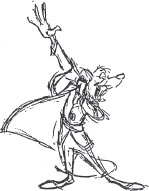86 A Drawing Style for Animation, Part II
Last week I reprinted some roughs as examples of a style of drawing. appropriate for animation, which I knew at the time were not fully explaining my point. They showed some beautifully drawn roughs that were loose and expressive, but didn’t explain or even given a hint at how they were arrived at.
Let’s take one of the drawings from last week’s “handout” and analyze it. The animator, Mark Henn, was not interested in

telling the part of the story that occurred on that particular frame of film. If he were interested in parts and the audience were too, this kind of thing would have satisfied both:

Animators are not just recorders of facts; they are storytellers, using their drawing vocabulary instead of words to spin a tale. They have at their disposal many exciting and dramatic ways to make expressive drawings, some of which are squash and stretch, twisting, contrast, angles, tension, perspective, and thrust. These are not physical things but they are what give life to physical things. (I emphasize “life” because without those things in a drawing it would be stiff, dull, and as I often point out in the drawing class, “too straight up and down”).
You can be sure this drawing wasn’t started with a detail of the head, or some other part of the body (as some of you are still tempted to do when drawing from the model).

It was started with a simple sketch of the whole action, then (and only then) were the details and finishing touches added.

At some point after the initial gesture is established, certain tensions and forces important to the gesture should be chosen, including all parts involved, and worked on as units of action. Every drawing will have a weight distribution or a stress or a thrust or a twist — a squash and stretch, a pull, a push, a drag — some action or actions that you will want to emphasize.
Choose those themes, story points, gesture topics, or whatever you want to call them and with all your awareness concentrate on them and accentuating them, “pressing home” their importance in what you are trying to say —in a word, caricaturing them.
For instance, in Mark’s drawing Basil is yakking about something as he goes through a flurry of putting on his coat. At this point in the action he has thrust his tight arm through the armhole, causing a stretch, and is pulling it over his shoulder with his left hand. That is one unit of action — the two hands pulling away from each other. There are others: the lower jaw pulling away from the nose area, the left foot pulling away from the right foot, and the corner or the cloak swinging away from his body. They are all part of the action, but they directly relate to one another.
So, to get the most out of these areas of action, you work one of the related parts against the other — never draw one part of the unit alone — but concomitantly the whole unit. For instance, you would not draw two unrelated parts such as his left arm and his left leg.

Rather you would work his left arm against his right arm.

Then (but not necessarily in that order) you would draw the two feet that work as a unit, pulling away from each other.

Then you would concentrate on the action of the corner of the cape as it stretches out away from his torso.

Then the head thrust, which is set up by the sum total of all the other parts. Notice how the nose direction is a continuation or rather a culmination of the whole body action. It’s clear from the left toe but also the belt line, the cape line, and the straight lines of the arms is almost like a “sounding board” for the yakking that is going on.

Some of the subtle poses that our models assume may be less extreme or dramatic but all the more reason for us to be cognizant of the importance of those vital elements in gesture drawing. It is so easy for a subtle pose to become another one of those “straight up and down,” self-conscious postures. On the other hand, it is “goose bump” time when those eloquent, meaningful, storytelling gestures come through in your drawings.
May the forces and stretches and angles and all other drawing helps be with you.
